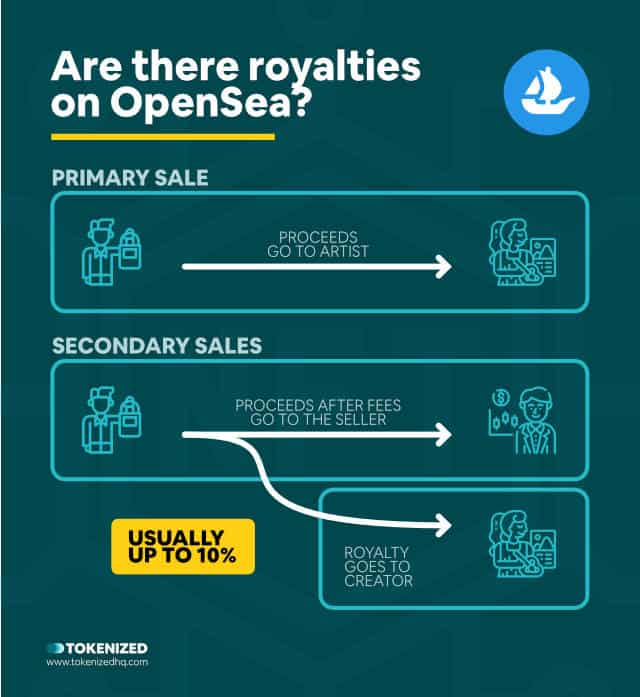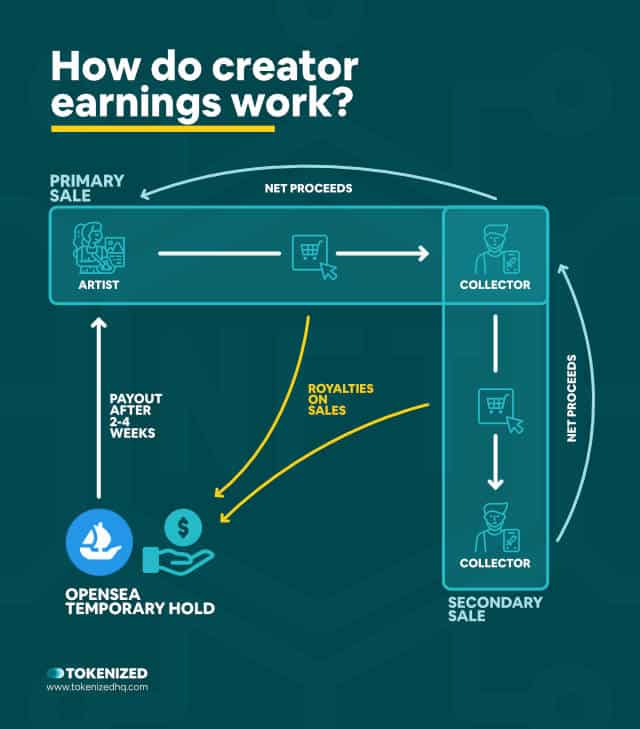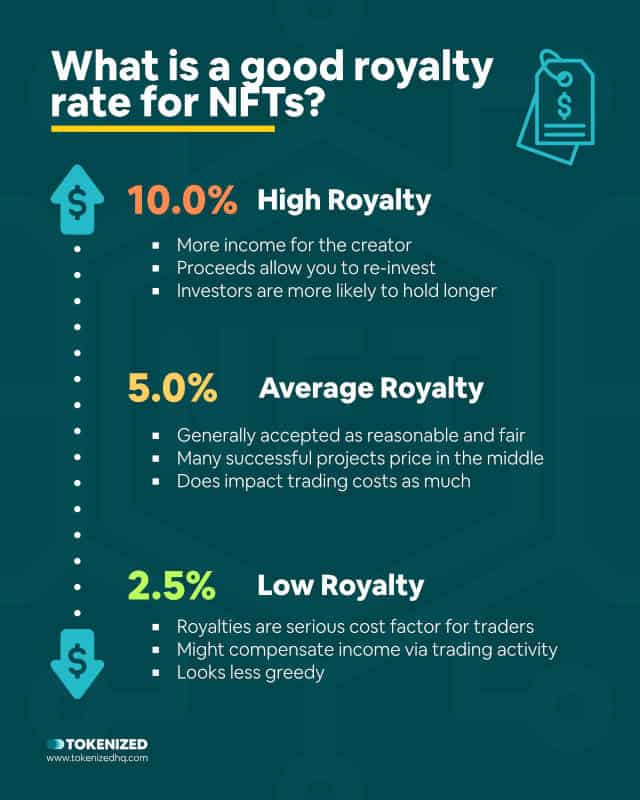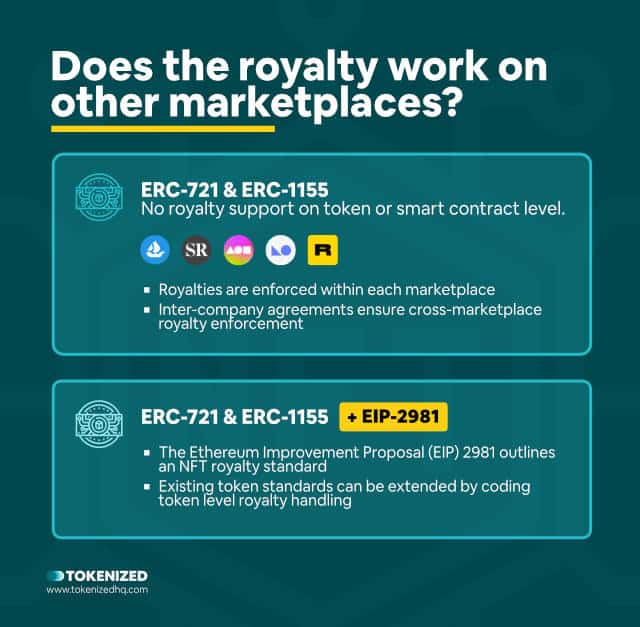Are you trying to understand how OpenSea royalties work?
Perhaps you understand the basic idea behind NFT royalty percentages, but you’re still a bit confused about how OpenSea creator earnings work?
Well, don’t worry, because we’ve put together answers to some of the most common questions about OpenSea royalties.
In this article, you’ll learn all you need to know about OpenSea royalties including whether these royalties work on other NFT marketplaces as well.
Let’s get started!
Key Points (tl;dr)
- OpenSea, like nearly all NFT marketplaces, supports NFT royalties.
- You can set your OpenSea creator percentage inside the settings of the collection that your NFT belongs to.
- Proceeds from primary sales flow directly into your address, however, all creator earnings including those from primary sales, are held by OpenSea for about 2-4 weeks before they are paid out.
- If you are building a bigger project and are using NFTs as a funding mechanism, we strongly advise you to set your NFT royalty percentage between 5% and 10% and reinvest the royalties into the project.
- While popular artists can easily claim similar royalties, we urge new artists to consider a percentage of 5% or less, simply because higher royalties tend to come with increased expectations of “utility” which many artists aren’t prepared for.
- While creator royalties are considered a standard in the industry, they are not automatically enforced on a token level and tend to be platform-specific. While technical solutions to this exist, some royalties are honored simply because major marketplaces have appropriate agreements in place.
For a detailed explanation of how OpenSea creator earnings work, PLEASE SCROLL FURTHER DOWN THE ARTICLE.
Like this content? Then share it!
Explained: How OpenSea Royalties Really Work
www.tokenizedhq.com
Here’s the answer. Great article by @ChrisHeidorn right here: https://tokenizedhq.com/opensea-royalties/
Are There Royalties on OpenSea?
Yes, there are royalties on OpenSea. Aside from the standard service fee that OpenSea charges on every transaction, royalties are the share of each sale that goes to the original creator. You can check a collection’s creator fee by checking out our article on how to see royalties on OpenSea.

If you’ve made your way to this article, then you probably already know that there are OpenSea royalties.
The problem is that many people confuse creator royalties with the service fees that OpenSea charges on every transaction.
Obviously, if you’re a trader, it’s all the same to you because royalties and service fees are cost factors that you need to take into consideration.
If you’d like to get a better overview, we strongly recommend checking out our article on OpenSea fees.
However, if you’re an artist, then your interest in OpenSea royalties is very different.
Not only would you want to know how to set royalties on OpenSea, but you’d also want to understand how OpenSea creator earnings work.
This is crucial because what many people don’t know is that there is a delay between the actual sale of your NFT and the payout of your royalties.
If you’re keen to know more about how royalties work on other NFT marketplaces such as Rarible, we recommend you check out our guide on Rarible royalties as well.
How Do OpenSea Creator Earnings Work?
OpenSea royalties as well as the payout address for creator earnings are set in the relevant collection settings. While proceeds from primary sales are immediately forwarded to the creator’s address, his royalties are usually held by OpenSea for a period of 2-4 weeks before they are paid out. It also applies to royalties on primary sales.

When an artist creates a new NFT and lists it on OpenSea, he can either auction off the item or set a fixed sales price.
Once the NFT is sold, the artists receive the proceeds from the primary sale minus the OpenSea service fee.
However, many creators are making use of the unique royalty feature of NFTs.
Royalties are not automatically set on OpenSea and in order to do so, you must first create a collection and then add the NFT to that collection.
Creator royalties, as well as the payout address, are defined at the collection level.
If you are not familiar with this process, make sure you check out our article on how to set royalties on OpenSea.
It’s actually all quite easy.
However, bear in mind that when you set an NFT royalty percentage, it will also impact the way your payouts work for primary sales.
You see, unlike proceeds from primary sales, royalties initially go to OpenSea where they are held for 2-4 weeks.
This also applies to the royalty portion of your primary NFT sale.
Only after this initial “holding period” your creator earnings are eventually paid out to your address.
While this may seem unnecessarily long or unfair, it’s actually common practice amongst most platforms that manage commission payments.
What Is a Good Royalty Rate for NFTs?
There is no perfect NFT royalty percentage. NFT projects that are seeking funding in order to build something bigger should consider OpenSea royalties between 5% and 10%. The same is valid for established artists who already have a following. However, if you do not fall into these categories, you should be below 5%. Higher NFT royalties usually also come with higher expectations from holders.

There really is no simple answer to the question of how high your NFT royalty percentage should be.
It all depends on various factors, including how popular you are as a creator, what you intend on doing with the funds from royalties, and whether you want to incentivize trading or not.
Bear in mind that a high creator royalty is more likely to stifle trading volume because it’s a real cost factor for traders.
A low creator royalty might feel like you’re getting less than you deserve, but is that really true when it’s effectively passive income?
OpenSea lets you set anything between 0% and 10%.
If you’re an unknown artist, then NFTs are most likely just an experiment for you, and royalties shouldn’t be your primary concern.
However, if you’re well established, then you will have fewer problems charging a higher royalty.
The higher you set your royalties, the greater the pressure will be for you to provide additional value to holders.
While an entrepreneur might reasonably expect that, for many artists, it’s a lot more pressure than they want.
Does the OpenSea Creator Royalty Work on Other Marketplaces?
The ERC-721 and ERC-1155 token standards do not support NFT royalties at a token level out-of-the-box. OpenSea royalties are still enforced on some major platforms, however, this is due to various legal agreements between platforms. The Ethereum Improvement Proposal EIP-2981 addresses this with an NFT royalty standard for existing token standards.

A common question amongst many people who are new to NFTs is whether the royalty functionality is platform-specific or whether it works anywhere.
Unfortunately, despite what is often claimed, the most common NFT standards ERC-721 and ERC-1155 do not support royalties on a token level.
This means that creator royalties that you set on OpenSea are not necessarily enforced on other platforms.
The same applies to an over-the-counter (OTC) deal where the payment is handled elsewhere and the NFT is simply transferred to the buyer’s address.
Obviously, this somewhat contradicts the whole idea behind creator royalties.
That being said, some of the major NFT marketplaces do have agreements in place, that ensure that they honor the royalty mechanisms of each platform (see this example of an agreement between OpenSea & Foundation).
Nevertheless, this is something that is already being worked on and will most likely evolve accordingly.
You can already use a combination of ERC-721/1155 and the new EIP-2981 royalty standard in order to code creator royalties at the token or smart contract level.
It’s only a matter of time before all newly minted NFTs end up using these new standards.
Stories of OpenSea Withholding Royalties
Over the past 2 years, there have been several reports of OpenSea withholding creator earnings longer than necessary.
While it’s hard to verify how many cases there were and how significant the impact was for the creators involved, it adds to the overall criticism of OpenSea.
It’s clear that OpenSea doesn’t lack the financial resources given the vast amounts of service fees they have been making.
Nevertheless, it’s absolutely possible that the startup has been completely overwhelmed with the speed at which it has scaled.
Ethereum gas fees have also been cited as part of the problem.
This makes sense when you’re paying out $100 in OpenSea royalties and paying $200 in gas to do so.
However, rather than just withholding creator earnings, adjusting the terms of service and issuing a public statement probably would have been the better approach.
Conclusion
The concept of NFT royalties is simple but there are important details that every creator and NFT trader should know.
OpenSea royalties on NFTs are a potential blessing for the artist scene.
Nevertheless, it’s important that you look at them as tools that can help you achieve something.
Royalties should not be seen as free, perpetual income.
NFT royalties will only continue to flow as long as the creator continues to provide value to his holders.
Here at Tokenized, we want to help you learn as much as possible about the coming NFT revolution. We help you navigate this fascinating new world of non-fungible tokens and show you how you can integrate tokenization into your own business.



